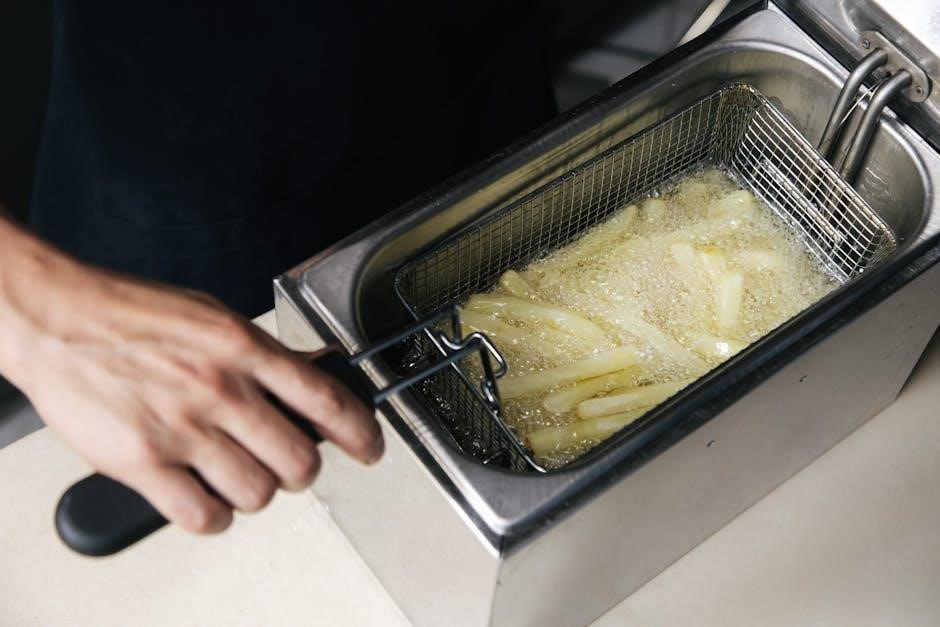Manual gearbox oil, essential for lubricating gears and ensuring smooth transmission operation, comes in types like hypoid and synthetic. Regular changes are crucial for longevity and performance.
1.1 Importance of Gearbox Oil in Vehicle Maintenance
Manual gearbox oil is crucial for reducing friction, preventing wear, and protecting gears from corrosion. It ensures smooth shifting and optimal performance. Regular oil changes, typically every 30,000 to 50,000 miles, are essential to maintain the gearbox’s longevity and functionality, preventing premature wear and ensuring reliable operation.
1.2 Overview of Manual Gearbox Components
A manual gearbox consists of interconnected toothed cylinders, or gears, mounted on central axes. These components work together to transmit power and control speed; The gearbox housing protects internal parts, while bearings and synchros facilitate smooth gear engagement. Proper lubrication with gearbox oil is vital to ensure all parts operate efficiently and durably, preventing overheating and wear.

Types of Manual Gearbox Oils
Manual gearbox oils include hypoid transmission oil, synthetic oils, and those with API ratings like GL-4 and GL-5, each designed for specific performance and protection needs.
2.1 Hypoid Transmission Oil
Hypoid transmission oil, such as SAE 75W-90, is commonly used in manual gearboxes. It provides excellent lubrication and wear protection, especially in high-stress applications. This oil is formulated to handle extreme pressures and temperatures, making it ideal for both standard and high-performance transmissions. Many manufacturers recommend hypoid oil for its ability to maintain viscosity and reduce friction between gears. It is widely available and often meets API GL-5 standards, ensuring compatibility with most manual gearboxes. Regular use of hypoid oil helps extend gearbox life and maintain smooth shifting performance.
2.2 Synthetic Gearbox Oils
Synthetic gearbox oils, like Redline MTL and Mobil 1, offer superior performance compared to conventional oils. They provide better lubrication at extreme temperatures, reducing wear and noise. Synthetics maintain viscosity stability, ensuring consistent gear engagement and smoother shifting. They are more durable, resisting breakdown under high stress, and can improve fuel efficiency. Although more expensive, synthetic oils are recommended for high-performance or heavily used manual transmissions. They also offer longer service intervals, making them a cost-effective choice for drivers seeking optimal gearbox protection and performance.
2.3 API and Viscosity Ratings
API ratings, such as GL-5 or MIL-L-2105B, indicate the oil’s performance level for manual gearboxes. Viscosity grades like SAE 75W-90 are common, ensuring proper lubrication across temperature ranges. Higher viscosity oils provide better gear protection at high loads, while lower viscosities improve cold-weather performance. Always match the specified viscosity and API rating to your gearbox’s requirements to avoid damage. Using the wrong oil can lead to increased wear or reduced efficiency. Adhering to these standards ensures optimal performance and longevity for your manual transmission.

How to Choose the Right Gearbox Oil
Selecting the correct gearbox oil involves considering viscosity, API ratings, and additives. Always refer to your vehicle’s manual for specific recommendations to ensure optimal performance and longevity.
3.1 Understanding Viscosity Grades

Viscosity grades in gearbox oil determine its flowability at different temperatures. Common grades like 75W-90 or 80W-90 indicate performance in cold (W) and hot conditions. Lower viscosity oils flow easier in cold weather, while higher viscosity oils provide better lubrication at high temperatures. Choosing the correct grade ensures proper gear lubrication, reduces wear, and prevents overheating. Always match the viscosity specified in your vehicle’s manual to maintain optimal transmission performance and longevity.
3.2 Role of Additives in Gearbox Oil
Additives in gearbox oil play a crucial role in enhancing performance and protecting components. Friction modifiers reduce wear on synchronizers and gears, while anti-wear agents prevent metal-to-metal contact. Corrosion inhibitors protect metal parts from degradation, and antioxidants extend oil life by preventing breakdown. Some additives, like shear-stable thickeners, maintain viscosity under stress. These additives ensure smoother shifting, reduce noise, and extend the lifespan of the gearbox. High-quality oils often include advanced additive packages tailored for specific transmission types and operating conditions.
3.3 Certifications and Standards
Certifications and standards for gearbox oil ensure compatibility and performance. API ratings like GL-4 and GL-5 specify oil characteristics for manual transmissions. SAE viscosity grades (e.g., 75W-90) indicate temperature performance. MIL-L standards define military-grade requirements. Always check your vehicle’s manual for recommended certifications. Using oil that meets these standards prevents damage and ensures optimal gear protection. Synthetic oils often exceed these standards, offering superior wear protection and thermal stability. Adhering to these certifications is crucial for maintaining warranty validity and ensuring long-term gearbox reliability.

Manual Gearbox Oil Capacity
Manual gearbox oil capacity varies by transmission type and vehicle specifications, typically ranging from 1 to 3 liters. Always consult your vehicle’s manual for precise requirements.
4.1 Factors Affecting Oil Capacity
Oil capacity in a manual gearbox is influenced by transmission type, vehicle specifications, and design. Manual gearboxes typically require 1 to 3 liters, while automatics may need more; The total capacity, such as 2.3 liters, determines how much oil is needed. Regular oil changes, often every 30,000 to 60,000 miles, also play a role. Additives like Lucas Oil Stabilizer can enhance performance. Always consult the vehicle’s manual for precise requirements to ensure optimal lubrication and gearbox longevity.
4.2 How to Determine Oil Capacity for Your Vehicle
To determine the oil capacity for your manual gearbox, consult your vehicle’s owner’s manual or manufacturer’s specifications. Online databases and repair manuals also provide detailed information. Check under the hood or near the transmission for a label indicating capacity. For most manual gearboxes, it typically ranges from 1 to 3 liters. If unsure, contact a certified mechanic or the dealership for precise guidance tailored to your vehicle’s make and model.
Changing Manual Gearbox Oil
Changing manual gearbox oil involves draining old fluid, replacing the filter, and refilling with the recommended type and amount. Regular changes ensure smooth operation and longevity.
5.1 Tools and Materials Needed

To change manual gearbox oil, you’ll need a drain pan, socket set, wrenches, and a ratchet. Additional tools include ramps or a jack, hex keys, and a torque wrench. Materials required are new oil filter, gasket, and the correct type of gearbox oil. Gloves and safety glasses are recommended for protection. Ensure all tools are compatible with your vehicle’s specifications. Having a waste container for used oil is also essential. Refer to your vehicle’s manual for specific tool sizes and requirements to complete the job efficiently and safely.
5.2 Step-by-Step Oil Change Process
Start by warming the gearbox with a short drive to circulate the oil. Raise the vehicle using ramps or a jack and secure it with jack stands. Locate the drain plug at the bottom of the gearbox and remove it using a socket wrench, allowing the old oil to flow into a drain pan. Replace the drain plug and fill the gearbox with the recommended type and amount of oil using a funnel. Refer to your vehicle’s manual for specific instructions and torque specifications. Tighten the drain plug securely and dispose of the used oil responsibly.
5.3 Disposal of Used Oil
Proper disposal of used gearbox oil is crucial to protect the environment. Never pour it down drains or mix it with household waste. Instead, collect the oil in a sealed container and take it to a recycling center or an auto repair shop that accepts used oil. Many service stations also offer oil recycling services. Check local regulations for specific guidelines in your area. Responsible disposal ensures harmful chemicals are safely processed and prevents environmental contamination.
5.4 Frequency of Oil Changes
Manual gearbox oil should be changed every 30,000 to 50,000 miles, depending on driving conditions. For severe use, such as frequent stop-and-go traffic or towing, more frequent changes (every 15,000 to 30,000 miles) are recommended. Always consult your vehicle’s owner’s manual for specific intervals. Regular oil changes help maintain smooth shifting, prevent wear, and extend the gearbox’s lifespan. Fresh oil ensures optimal lubrication and protects against corrosion, keeping your transmission in peak condition for years to come.

Maintenance Tips for Manual Gearbox
Regularly check oil levels, clean the gearbox, and inspect for leaks to ensure optimal performance and longevity. These simple steps prevent wear and maintain smooth operation.
6.1 Monitoring Oil Levels
Regularly monitoring the oil level in your manual gearbox is crucial for maintaining its health. Most manual gearboxes typically require 1 to 3 liters of oil, depending on the model. Always refer to your vehicle’s owner’s manual for specific guidance. Check the oil level when the car is on a level surface and the engine is warm. Low oil levels can cause noisy operation or shifting difficulties. If the oil level is consistently low, inspect for leaks. Overfilling can also damage the gearbox, so ensure the level is within the recommended range. Use a dipstick or follow the manual’s procedure for accurate measurement.
6.2 Cleaning the Gearbox

Cleaning the gearbox is essential for maintaining its performance and longevity. Use a drain pan to collect old oil during changes. Inspect for debris or contaminants and wipe surfaces with a clean rag. Avoid harsh chemicals that may damage seals or gaskets. After draining, refill with the recommended oil type and viscosity. Regular cleaning prevents sludge buildup and ensures smooth gear operation. Always refer to your vehicle’s manual for specific cleaning procedures and torque specifications for drain plugs. Proper cleaning is a key part of routine maintenance.
6.3 Inspecting for Leaks
Regularly inspecting your manual gearbox for leaks is crucial to prevent fluid loss and damage. Check the drain plug, seals, and gaskets for any signs of moisture or drips. Use a clean rag to wipe surfaces and look for discoloration or stains. Addressing leaks promptly prevents contamination and ensures optimal lubrication. If a leak is found, tighten any loose connections or replace worn seals. Always use a torque wrench to avoid over-tightening. If unsure, consult a professional to avoid further damage. Regular inspections help maintain gearbox health and performance.
Signs Your Gearbox Oil Needs Changing
Noisy operation, slipping gears, and discolored oil are key indicators that your gearbox oil needs changing. These signs signal wear and tear, requiring immediate attention.
7.1 Noisy Operation
Noisy operation is a clear sign your gearbox oil needs attention. Unusual sounds like grinding, whining, or clunking indicate wear or insufficient lubrication. Low oil levels or contamination can cause these noises, leading to premature wear. Synthetic oils, known for their superior lubrication properties, can help reduce noise and improve shifting smoothness, especially in colder conditions. Ignoring these signs can result in costly repairs. Always consult your owner’s manual for the recommended oil type and change interval to maintain optimal performance and prevent further damage.
7.2 Slipping Gears
Slipping gears are a concerning symptom that often indicates worn or degraded gearbox oil. When oil loses its viscosity or becomes contaminated, it fails to provide proper lubrication, causing gears to slip or hesitate during shifts. This can lead to inconsistent acceleration and poor control. Fresh, high-quality oil, such as synthetic or hypoid gear oil, can restore smooth shifting. Regular oil changes, typically every 30,000 to 50,000 miles, are crucial to prevent this issue. Ignoring slipping gears can result in costly damage to gear teeth and synchronizers, requiring extensive repairs.
7.3 Discoloration of Oil
Discoloration of gearbox oil, such as turning dark or black, signals contamination from metal shavings or dirt. This indicates the oil is no longer effectively lubricating gears, potentially causing wear. Fresh oil should be clear or amber-colored. If discoloration occurs, an immediate oil change is recommended. Regular checks and changes, typically every 30,000 to 50,000 miles, help maintain oil quality and prevent gearbox damage. Ignoring discolored oil can lead to premature wear on gears and synchronizers, requiring costly repairs.
Troubleshooting Common Gearbox Issues
Identify leaks by inspecting seals and gaskets. Address shifting difficulties by checking fluid levels and filter condition. Diagnose noise by listening for grinding or whining sounds during operation.
8.1 Diagnosing Leaks
Diagnosing leaks in a manual gearbox involves inspecting seals, gaskets, and drain plugs for damage or wear. Common causes include worn synchronizer seals or damaged shaft seals. Start by visually examining the gearbox for oil droplets or stains. Use a UV dye kit to trace the source of the leak under UV light. Check the oil level regularly, as low levels can indicate a breach. Addressing leaks promptly prevents further damage and ensures optimal gearbox performance. Always use the correct lubricants to maintain seal integrity and prevent premature wear.
8.2 Addressing Shifting Difficulties
Shifting difficulties in a manual gearbox can stem from improper oil viscosity, contamination, or worn components. Using the correct oil grade ensures smooth gear engagement. If shifting feels notchy or stiff, check for debris or old oil degrading clutch packs. Adding additives like Lucas Oil Stabilizer can improve shifting in older gearboxes. Regular oil changes prevent contamination and maintain optimal lubrication. Addressing these issues promptly ensures smoother operation and prevents further damage to synchronizers or gears.
8.3 Resolving Noise Problems
Noise issues in a manual gearbox often indicate insufficient lubrication or improper oil viscosity. Low oil levels can cause gears to grind, leading to whining or clunking sounds. Using the correct viscosity grade ensures proper lubrication and reduces wear. Debris from worn components can also cause noise. Regular oil changes help remove contaminants and maintain smooth operation. If noise persists, inspect for worn bearings or gears. Adding high-quality additives can sometimes reduce noise temporarily, but persistent issues may require professional inspection and repair to prevent further damage.

Gearbox Oil and Vehicle Performance
Fresh gearbox oil enhances fuel efficiency, ensures smoother shifting, and prolongs transmission life. High-quality oils reduce friction and wear, improving overall vehicle performance and reliability over time.
9.1 Impact on Fuel Efficiency
Proper manual gearbox lubrication significantly impacts fuel efficiency. High-quality gearbox oils reduce friction between gears, minimizing energy loss and lowering engine load. Regular oil changes ensure optimal viscosity, preventing overheating and wear. Fresh oil enhances gear engagement smoothness, reducing unnecessary fuel consumption. Over time, clean oil maintains transmission health, contributing to consistent performance. Neglecting oil changes can lead to increased friction, reducing fuel economy. Synthetic oils, with better thermal stability, further improve efficiency. Adhering to recommended change intervals (every 30,000–50,000 miles) ensures your vehicle runs efficiently, saving fuel and extending gearbox life.
9.2 Role in Smoother Shifting
Manual gearbox oil plays a crucial role in ensuring smoother shifting by reducing friction between gears and synchronizers. High-quality oils, such as synthetic variants, maintain optimal viscosity, preventing gear hesitation. Clean oil enhances synchronizer engagement, making shifts feel more precise and effortless. Degraded or old oil can lead to rough shifting and hesitation, especially in cold conditions. Regular oil changes with the correct viscosity grade, such as 75W-90, ensure consistent performance. Additives in modern gearbox oils further improve shifting smoothness by protecting components from wear. Proper lubrication is essential for maintaining seamless gear transitions and driver comfort.

9.3 Contribution to Longevity
Manual gearbox oil significantly contributes to the longevity of transmission components by reducing wear and preventing corrosion. Clean oil ensures gears and bearings operate smoothly, minimizing friction that could lead to premature damage. Regular oil changes remove contaminants and debris, protecting the gearbox from internal degradation. High-quality oils, such as synthetic variants, offer superior protection against heat and stress, extending the lifespan of the transmission. Proper lubrication ensures components last longer, reducing the need for costly repairs and maintaining optimal performance over time.
Regular maintenance of manual gearbox oil is crucial for optimal performance and longevity. Using the correct oil type and following recommended change intervals ensures smooth operation and prevents wear. Synthetic oils offer enhanced protection, especially in extreme conditions. By adhering to these practices, drivers can extend the life of their gearbox, reduce repair costs, and maintain efficient power transmission. Proper care of gearbox oil is essential for sustaining vehicle health and ensuring reliable operation over time.